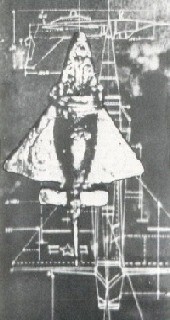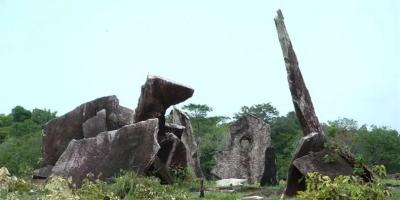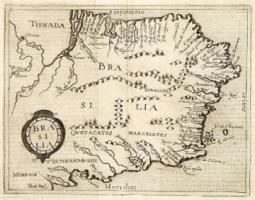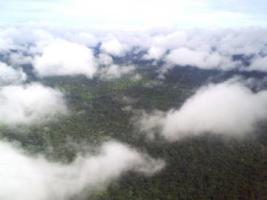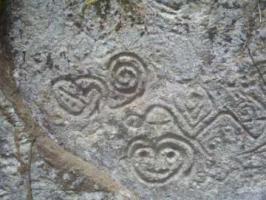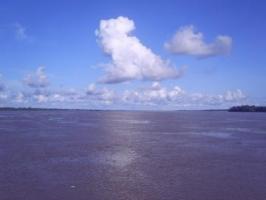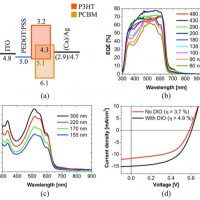Prehistory of the Amazon

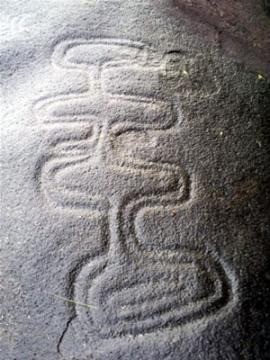
The Amazon area has been populated since the tenth millennium BC. There are several theories that explain the origin of the population in America and in particular, in the Amazon.
It is universally accepted that approximately 14 millennia ago groups of Homines Sapientes crossed what was once a plain called Beringia (the present-day Bering Strait between Siberia and Alaska).
These ancient travelers, originally from eastern Siberia, moved northeast for generations, pursuing herds of mastodons, bison, and caribou.
Upon entering the American continent, they found an ice-free corridor, which they crossed until they reached the plains of North America, the current central-western United States.
Initially, these human groups sustained themselves exclusively from hunting. Later, with the Neolithic revolution, they dedicated themselves to agriculture and harvesting.
As the centuries passed, several tribes migrated south, in a process of colonization of the entire American continent, which lasted several millennia. They also arrived in the Amazon, around the tenth millennium BC.
There are other theories, such as the "polygenetic theory", according to which people of origin from Africa, Australia, Melanesia and Polynesia arrived in America by crossing the oceans in ancient times, later mixing with those of Asian origin who arrived from the north.
The African theory is supported by the remains found at the site of Pedra Furada, in Brazil, which prove that there has been human presence there for 60 millennia.
Entire centuries were necessary to perfect the practical and technological knowledge necessary for the use of plants such as corn (zea mays), cassava (manihot esculenta), sweet potato (ipomea batatas) or medicinal and stimulant plants such as coca (erythroxylum coca) or hallucinogenic drugs such as ayahuasca (banisteriopsis caapi) or drunkenness (brugmansia).
The people of the Amazon reached a high level of knowledge of the soils, climate and organic cycles, and managed to live in harmony with nature for millennia. Shortly before the arrival of the Europeans, the total population of South America was about thirty million people. The majority (twenty million) lived in Tahuantinsuyo (the empire of the Incas), while another approximately five million lived between the southern cone and the territory currently occupied by Colombia and Venezuela. The last five million people, according to the most authoritative estimates, lived in the Amazon.
The three predominant languages in the prehistoric Amazon were: Arawak, Caribe and Tupí-Guaraní.
The influence of the ethnic groups that spoke Arawak before the arrival of Europeans to the New World extended from present-day Florida to Bolivia. This name derives from a word used by the Spanish, Araguacos, to refer to a tribe from Venezuela, while they called themselves lukkunu (the men). Their physical characteristics were as follows: short stature (no more than 160 centimeters), long face, black hair, slanted eyes and olive skin. They expanded across enormous territories, probably to search for new land suitable for agriculture. One of their first migrations was the one that took the Uros to the Andean plateau (Uros tribes still live on floating islands on Lake Titicaca today). The origin of the Arawak-speaking ethnic groups seems to be the north of the Amazon, where they dispersed in various directions.
The Caribbean-speaking peoples were the first that Europeans encountered upon their arrival in the New World. This name has an ancient origin: it derives from the words calina and caripuna, which Columbus met in Hispaniola and appeared on a 16th century map by the Milanese historian Pedro Mártir de Anglería.
The Caribbean-speaking indigenous people were taller than the Arawak-speaking natives and, in general, more warlike and violent. Their place of origin seems to be the upper Xingu, in the southern Amazon, from where they emigrated, some colonizing the Antilles, others crossing the Andes and settling in the Colombian plains (the Zenúes, who were decimated by the raids of Pedro de Heredia in 1533, they spoke a Caribbean language).
The Tupí-Guaraní language peoples extended from the Andes to the Atlantic and from the Guyana massif to the Río de la Plata. Upon the arrival of the conquerors, the Tupí ethnic groups lived in the coastal areas, from the estuary of the Amazon River to the current south of Brazil. It seems that the place of origin of the Tupí-Guaraní language peoples is the upper Paraná, from where, through the Xingu River, they spread towards the Amazon.
Some linguists maintain that the Arawak, Caribbean and Tupí-Guaraní languages have surprising affinities and perhaps a common origin. If this were the case, one could conclude that, in the remote past, a single people lived in the Amazon.
Perhaps between the tenth and eighth millennium BC, after enormous climate changes, this primordial ethnic group split and some tribes migrated to the Andean zone, where they joined people of the Chibcha, Quechua and Aymara languages.
The analysis of the soils allows us to realize that in the Amazon, starting in the fifth millennium after Christ, the “slash and burn” technique and alternating crops were adopted, which made it possible to obtain surplus production of cassava and corn.
In approximately one twentieth of the current Amazonian forest area (corresponding to 250,000 square kilometers), there is a particular type of soil, called in Portuguese terra preta (black earth). These particularly fertile lands, which anthropologists consider to be a product of man, precisely after the technique called “slash and burn,” are proof that the Amazonian peoples practiced a form of intensive, large-scale agriculture.
According to Donald Lathrap, an important scholar from the 1970s, groups of proto-Arawak, who lived in the central Amazon in the third millennium BC, were able, through dehydration, to eliminate the harmful prussic acid from the cassava.
This town practiced hunting with bows, arrows and blowguns and fishing with wooden traps in rivers and lakes.
In the vicinity of the confluence between the Negro River and the Amazon River, ceramic crafts belonging to the third millennium BC were also found.
Another piece of evidence of the archaic population of the Amazon is the Pedra Pintada cave, located on the left bank of the Amazon River, near the city of Monte Alegre. In this grotto, which was studied in 1950 by Alfred Russel Wallace, there are several cave paintings and petroglyphs showing human figures and stylized animals, usually colored red, yellow and brown. There are also geometric drawings that encourage us to think about possible astronomical knowledge. Man inhabited these caves in a period between the tenth and third millennium BC, thus demonstrating that indigenous populations lived and prospered in the Amazon at the same time as the Clovis culture flourished in North America.
From a spiritual point of view, the people of the Amazon practiced complex rituals of Asian origin called “shamanic practices.” According to these cults, man was conceived as part of the universe and its physical and cosmic laws.
Totems were of great importance, symbolic representations of real animals or mythical beings that were considered the ancestors of a set of families (clan) or tribes (groups of clans).
Around 1970, archaeologist Betty Meggers studied the island of Marajó, located in the estuary of the Amazon River. On this fluviomarine island, the flourishing culture of the Marajoara people developed, starting in the 15th century BC. It was mainly the discoveries of ceramics, with drawings of Amazonian animals and plants, that prompted Meggers to continue excavating. She quickly realized that the older discoveries were more elaborate, as if a more complex culture had flourished in the past.
The Marajoara indigenous people did not build imposing walls or megalithic monuments like those of Tiwanaku or Chavin de Huantar, however, theirs was an orderly society and probably governed by caciques (chiefs of indigenous communities), who also had spiritual power. Following the excavations of Betty Meggers, richly decorated tombs used to bury spiritual leaders were found.
Another amazing discovery was the 127 granite blocks placed in a circle in the vicinity of Calcoene, in the interior of the state of Amapá, in Brazil. According to archaeologist Martina Cabral, this monument is to be considered an astronomical observatory whose age is estimated to be about three millennia. These stone blocks, up to three meters high, were used to calculate the solstices, equinoxes and cycles of the moon in order to orient oneself, decide the favorable times for sowing and divination.
As can be seen, current archaeological discoveries suggest a group of people with advanced culture who lived in the prehistoric Amazon.
Was that the famous “third empire of America”, which the Spanish conquerors sought for a long time? For now we do not have enough information to scientifically answer this question.
When the climate changed, around the sixth millennium BC, some of these peoples migrated westward, mixing with Aymara and Quechua speaking ethnic groups and giving rise to refined cultures such as Caral, Tiwanaku and Chavin de Huantar.
On the contrary, the populations that remained in the Amazon became accustomed to living in an increasingly humid environment. They did not practice metallurgy due to lack of metals and their societies were not stratified, except perhaps for the Marajoara, because there was no real competition for food. Indeed, the abundance of resources, whether plant or animal, contributed to making these people peaceful societies, where little trade was practiced between the different tribes and where technological advances were slow.
When the first Europeans arrived at the estuary of the Amazon River, with the expeditions of Américo Vespucci in 1499 and Vicente Yáñez Pinzón in 1500, they found themselves facing dense populations, whose economy was based on agriculture and fishing. Forty-two years later, Francisco de Orellana traveled almost completely along the Amazon River, from the confluence with the Napo River to the estuary, and had contact with numerous natives who lived on the banks of the river.
Unfortunately, the viruses brought unconsciously by Europeans (and their animals), among which was smallpox, quickly decimated the natives. Only a century later, during the expedition of the Portuguese Pedro Texeira, the Amazon basin was no longer that fantastic and ancestral world populated by numerous tribes that Orellana had seen, but was just a huge, almost uninhabited “endless” jungle, crossed by the largest river on Earth, the colossal Amazon River.
YURI LEVERATTO









